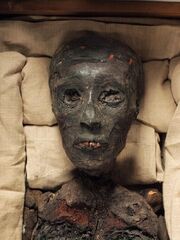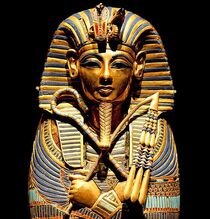Tutankhamun was born c 1341 B.C with the name Tutankhaten, meaning "the living image of Aten." After becoming the 12th pharaoh of the 18th Egyptian dynasty in 1332 B.C., he converted his name to Tutankhamun, which means "the living image of Amun." In the same year, King Tutankhamun married his half sister Ankhesenamun with whom he had two stillborn children. Tutankhamun's reign saw the restoration of the Egyptian polytheistic religion previously suppressed by Akhenaten.
Mummification[]
The mummification process in Tutankhamun's time took 70 days, the organs were extracted, the body was cleaned out with wine and water and dried with linens. The body was then immersed in a naturally occurring salt for 40 days and then the body was anointed with oils and wrapped with linen bandages before a priest would recite prayers.

The pharaoh was buried in a tomb that was too small considering his status, suggesting that his sudden death happened before his tomb was finished; so he was buried in someone else's tomb.
Studies[]
On November 26, 1922, archaeologists Howard Carter and George Herbert discovered and entered the tomb of Tutankhamun. Upon entry, they witnessed that much of the original structure and content of the tomb had stayed intact. Within one of Tutankhamun's chambers were murals painted on the walls depicting the events of his funeral and his journey to the afterlife. In addition to the murals, the chamber was also filled with artifacts including: oils, perfumes, toys, jewelry and statues made of gold and ebony. It would take Carter and his team 20 years to excavate and empty the tomb.
Pathology[]
Research shows that Tut had a slight cleft palette and scoliosis of the spine. Examination of Tut's body shows that he had deformations in his left foot due to necrosis of the tissue.
In DNA tests of Tut's bones, it was found he had a mosquito-borne parasite, malaria-tropics. The malaria would have caused King Tut's immune system to weaken, which would have interfered with the healing of his left foot. All of these health factors which scientists had discovered in 2005, may have ultimately been what killed the young king. The cause of Tutankhamun’s death is unclear and is still the root of much speculation.
Tutankhamun was slight of build, and was roughly 180 cm (5 ft 11 in) tall. He had large front incisors and the overbite characteristic of the Thutmosid royal line to which he belonged. Between September 2007 and October 2009, various mummies were subjected to detailed anthropological, radiological, and genetic studies as part of the Tutankhamen Family Project. It was determined that none of the mummies of the Tutankhamen lineage has a cephalic index of 75 or less (indicating dolichocephaly), that Tutankhamen actually has a cephalic index of 83.9, indicating brachycephaly, and that none of their skull shapes can be considered pathological.
Additional[]
Tutankhamen's mummy still rests in his tomb in the Valley of the Kings. On 4 November 2007, 85 years to the day after Howard Carter's discovery, the pharaoh went on display in his underground tomb at Luxor, when the linen-wrapped mummy was removed from its golden sarcophagus to a climate-controlled glass box. The case was designed to prevent the heightened rate of decomposition caused by the humidity and warmth from tourists visiting the tomb.
References[]
"Classroom TUTorials: The Many Names of King Tutankhamun" (pdf). Michael C. Carlos Museum. Retrieved October 5, 2015.
Handwerk, Brian (8 March 2005). "King Tut Not Murdered Violently, CT Scans Show". National Geographic News. p. 2. Retrieved October 5, 2015.
Hankey, Julie (2007). A Passion for Egypt: Arthur Weigall, Tutankhamun and the 'Curse of the Pharaohs'. Tauris Parke Paperbacks. pp. 3–5. ISBN 978-1-84511-435-0. Retrieved October 5, 2015.
http://listverse.com/2009/12/24/top-10-famous-mummified-bodies/
Biography.com Editors. (2017, August 10). King Tut Biography.com. Retrieved from https://www.biography.com/people/king-tut-9512446
History.com Staff. (2009). Tutankhamen. Retrieved from http://www.history.com/topics/ancient-history/tutankhamen
Wkipedia Retrieved from http://en.wikipedia.org/wiki/Tutankhamun
